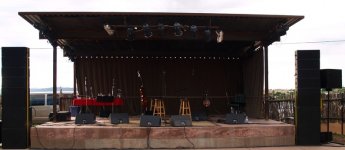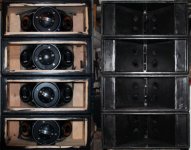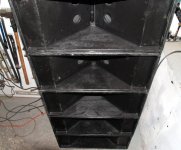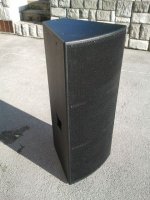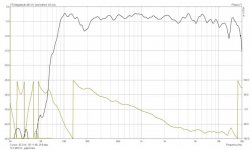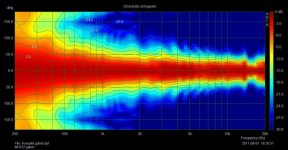i know this is the subwoofer section so move if need be. i am looking for a design or maybe a fresh design for tops that will match Xoc1's T18. i hope i can get my 4 T18s cut out this week. anyways, thinking a 2-12 either horn or reflex loaded cabinet with a 1" or 2" high driver. i plan to run the T18 with the 18sound 18lw2400 driver.
The problem with most tops is getting them to go low enough to actually meet the subs.... especially if the sub won't be crossed any higher than about 80hz.
Remember to model in 4pi, because they won't be sitting on the ground when you do hornresp.....
and yea, for the reason of trying to get them to match to a specific sub... it's kinda appropriate in this forum.
Remember to model in 4pi, because they won't be sitting on the ground when you do hornresp.....
and yea, for the reason of trying to get them to match to a specific sub... it's kinda appropriate in this forum.
One of the reasons that I have not built any TH18 cabs for myself yet is the fact that my current mid tops don't go below 180Hz. No one seems to have pushed the TH18 much above 100Hz, but it seems to show a reasonably extended response.
See this Plot from SG3525
http://www.diyaudio.com/forums/subwoofers/190635-th-18-flat-35hz-xoc1s-design-31.html#post2662947
I have been concidering building some new mids. Ny current thoughts are to build a reflex loaded 2 x 10" with a single new high efficiency +108 dB/W compression driver.
To get any real benefit from the reflex port it needs to be tuned higher than needed for a flat response - The limitation being Xmax. Also the phase response compared to a sealed mid is pretty lumpy!
See this Plot from SG3525
http://www.diyaudio.com/forums/subwoofers/190635-th-18-flat-35hz-xoc1s-design-31.html#post2662947
I have been concidering building some new mids. Ny current thoughts are to build a reflex loaded 2 x 10" with a single new high efficiency +108 dB/W compression driver.
To get any real benefit from the reflex port it needs to be tuned higher than needed for a flat response - The limitation being Xmax. Also the phase response compared to a sealed mid is pretty lumpy!
Crossing at 100 Hz I use fourteen Eminence Alpha 8" and five EV DH1AMT (3" diaphragm, 1.5" exit) drivers above each of my Keystone 18" TH, which is similar in output to the XOC1 TH-18.i plan to cross at 100hz. i really don't have an understanding of hornresp reason i am leaning towards a reflex 2-12 box.
The small format line array tops driven with 1800 watts mids, 900 watts highs, have the needed headroom to sound clean with live music when the subs are using around 3000 watts apiece.
In terms of output level design, around 10% distortion generated at around 40-50 Hz Xmax is acceptable for LF as the harmonics still are generally below the vocal range, but a mid driver hitting Xmax around 125 Hz generates harmonics in the 250, 375, 500 Hz range, which sounds pretty dirty.
I would suggest around four 12" BR per side using a pair of 3" or 4" diaphragm HF drivers, or six 10" if using 1.75" diaphragm 1" exit drivers.
Also remember that HF driver sensitivity is usually measured midband, on a constant directivity horn 10-20 dB of HF boost is often needed to approach flat response even before considering HF air attenuation losses.
Art Welter
Crossing at 100 Hz I use fourteen Eminence Alpha 8" and five EV DH1AMT (3" diaphragm, 1.5" exit) drivers above each of my Keystone 18" TH, which is similar in output to the XOC1 TH-18.
The small format line array tops driven with 1800 watts mids, 900 watts highs, have the needed headroom to sound clean with live music when the subs are using around 3000 watts apiece.
In terms of output level design, around 10% distortion generated at around 40-50 Hz Xmax is acceptable for LF as the harmonics still are generally below the vocal range, but a mid driver hitting Xmax around 125 Hz generates harmonics in the 250, 375, 500 Hz range, which sounds pretty dirty.
I would suggest around four 12" BR per side using a pair of 3" or 4" diaphragm HF drivers, or six 10" if using 1.75" diaphragm 1" exit drivers.
Also remember that HF driver sensitivity is usually measured midband, on a constant directivity horn 10-20 dB of HF boost is often needed to approach flat response even before considering HF air attenuation losses.
Art Welter
you have a picture of this set up?
As Art points out there is definitely a need to determine what SPL you want to acheive.
Not everyone will have the drivers, amplifiers, or plug socketsto be able to get these high levels!
I run my system which includes the above described 28 eights, 10 HF drivers, two 18" as well as eight dual eight stage monitors off of two standard 120V 20 amp circuits, hard to find any home (or crap nightclub...) that does not have that much power.
I have, by mistake, run it off one circuit, found out when a miswired guitar amp caused the breaker to pop during a sound check.
I do try to get a separate circuit for stage gear to avoid that type of problem.
Twenty 8" speakers were not quite enough to keep up with the pair of 18" TH subs at 100 Hz, needed another eight 8" to get enough clean output around 100 Hz.you have a picture of this set up?
The outdoor picture shows the tops on top of dual Lab 2x12", the third cabinet up is a 4x8" without the HF drivers. The Keystone TH is the same size as the pair of dual Lab 2x12".
The top cabinets on a stick on the right side are covering a dance area to the side of the main coverage.
The top cabinets are 11.25 tall, 15" deep, 26.5" wide.
The straps have been painted black since the picture
Art
Attachments
As Art points out there is definitely a need to determine what SPL you want to acheive.
Not everyone will have the drivers, amplifiers, or plug socketsto be able to get these high levels!
i don't need a ton of SPL. most of the shows i play are small indoor, but through the summer i play several outdoor shows. i figure i will have head room with the T18s for most of my indoor shows.
if i went with the 4 -12" and 2 compression configuration, what are the rules for locating the 12" so they don't suffer from cancellation.
Art, i have messed around with a drawing similar to your cabinets, only with 12s.
I would suggest a normal BR design. I had the same problem finding the right tops for my LAB subs. I really like horn designs but it's hard to make them go low enough to meet with modern subs. So we decided to try a BR approach. From all the horn building we done I almost forgot how nice a god BR design can play 
We decided on a 2x12" + 1,4" combo. Mid drivers are B&C 12NDL76 and high is 18sound ND1460A on a XT1464 horn.
The dip around 190Hz is from the height difference from the ground to the mic. Ground plane measurements show a flat response.
We decided on a 2x12" + 1,4" combo. Mid drivers are B&C 12NDL76 and high is 18sound ND1460A on a XT1464 horn.
The dip around 190Hz is from the height difference from the ground to the mic. Ground plane measurements show a flat response.
Attachments
Last edited:
Not for 8" speakers.art:
aren't your "unity" ports a bit big?
Most of the designs you have seen are probably using 4-6" drivers, which have a smaller enclosed volume behind the ports.
The ports are fairly close to the ones used on the VTC line array (Danley licenses the Paraline and Synergy concepts to Yorkville, VTC is a subsidary of Yorkville) which my design is similar to.
I determined the port size through testing several different sizes, too small or too big both have problems, getting it "just right" took a while.
Modeling in Hornresp would have narrowed the port size selection process down quite a bit, but I (re) built those cabinets in 2008, and only got in to Hornresp last year.
At any rate, I have never been happier with a system than this one, the dispersion is completely uniform (-6 dB at 45 off axis) over 90 degrees down to Fc, and the line array/Paraline effect makes the front to back coverage very consistent.
In fact, a few engineers who recently mixed on the system were surprised to find that the mid/high level was actually slightly louder at the mix location (about 75 foot back in a 150' deep room) than it was at 10-20 feet from the speakers.
Art
Last edited:
If going front loaded, the "rule" would be a vertical alignment, HF horns on top, possibly with a mid rolloff on the lower 12" cones.if i went with the 4 -12" and 2 compression configuration, what are the rules for locating the 12" so they don't suffer from cancellation.
If using a Paraline/Synergy horn approach, the port exits should simply be placed as close to the horn apex as possible.
A 12" will acoustically fall off around 600 Hz with the Synergy style port loading, which is a (huge) stretch for most 1" exit drivers, you would probably need a 1 12" to 1 1" ratio to keep the HF driver excursion low enough to keep up.
The VTC EL210 uses 2 x10" and 2 x 1", the 10" only make 650 Hz before a rapid fall off, my 8" design only goes a bit higher.
The 3" diaphragm EV DH1AMT HF drivers I use load down to around 300 Hz, over an octave below the cutoff the VTC 1" has.
Art
The 3" diaphragm EV DH1AMT HF drivers I use load down to around 300 Hz, over an octave below the cutoff the VTC 1" has.
Art
that explains it nicely... They didn't look small enough to get anywhere near about 800hz which was my guess....
Technically it is a Synergy horn, since it uses a Paraline deviceHi Art,
Did you use a passive crossover on your unitys, or how did you solve that puzzle?
Regards,
Passive crossovers are not very useful for PA work, the components for a dozen cabinets would cost a lot more than a DSP, and waste most of the power sent to the HF, reducing headroom.
Even though the ports create a steep acoustic crossover, there are out of band peaks that still need attenuation, frightfully hard to do with a passive crossover. I also use different amounts of cabinets on occasion,and sometimes with a large waveguide, different corrective EQ is required for each set up.
I am using DBX DriverackPa for DSP, it has just enough PEQ and delay to work.
Although I am quite pleased with the small format line array (and the individual cabinets weigh only 50 pounds apeice, so I can stack by myself) for most DJ type gigs, the even response a line array can provide is not a big selling point.
That said, I built a pair of 2x10" with a HF horn that each weigh around 80 pounds, I'd rather stack the 250 pounds of SFLA one at a time than lift those buggers to head level.
Art
- Status
- This old topic is closed. If you want to reopen this topic, contact a moderator using the "Report Post" button.
- Home
- Loudspeakers
- Subwoofers
- Tops to accommodate Xoc1's T18
